expressive art therapy activities pdf
Summary
Discover creative healing with our expressive art therapy activities. Download PDF guides for therapeutic exercises and artistic expression.
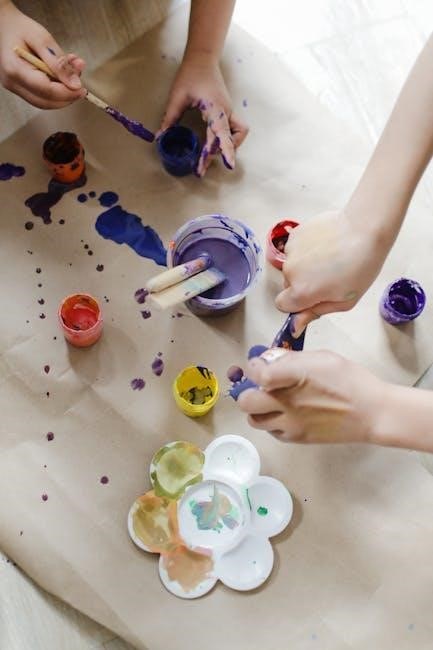
Expressive Art Therapy combines creative activities like painting, music, and drama to help individuals process emotions and promote healing. It offers a holistic approach to fostering personal growth and emotional well-being through artistic expression.
1.1 Definition and Overview
Expressive Art Therapy is a holistic, intermodal approach integrating various art forms—such as painting, music, and drama—to promote emotional healing and self-expression. It encourages individuals to explore and process emotions through creative activities, fostering personal growth and well-being. Unlike traditional art therapy, which may focus on a single medium, expressive art therapy emphasizes the therapeutic process over the final product, making it accessible to all, regardless of artistic skill. This modality bridges creativity and psychology, offering a powerful tool for inner transformation and healing.
1.2 History and Development
Expressive Art Therapy emerged in the 20th century, drawing from psychotherapy, art education, and creative expression. It evolved by integrating music, drama, and movement with visual arts, creating a multi-modal approach. Early practitioners emphasized the therapeutic potential of creativity, shifting focus from artistic skill to emotional expression. This approach gained recognition as a distinct form of therapy, blending psychological principles with artistic processes to foster healing and self-discovery. Its development reflects a growing understanding of art’s role in mental health and personal growth.
1.3 Key Principles and Objectives
Expressive Art Therapy is rooted in the belief that creative expression fosters emotional healing and personal growth. Its key principles include the integration of multiple art forms, such as painting, music, and movement, to access and process emotions. The primary objective is to provide a safe space for self-expression, promoting emotional regulation, and enhancing mental well-being. By focusing on the creative process rather than the final product, individuals can explore their inner experiences and achieve therapeutic outcomes.
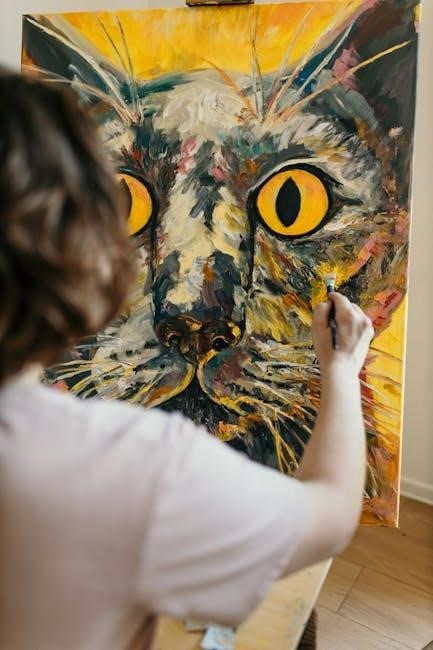
Benefits of Expressive Art Therapy
Expressive Art Therapy helps individuals process emotions, reduce stress, and enhance self-awareness. It fosters emotional healing, creativity, and mental well-being through activities like painting, music, and movement.
2.1 Emotional Regulation and Healing
Expressive Art Therapy helps individuals regulate emotions by channeling feelings into creative activities. Painting, music, and movement enable participants to process trauma and stress, fostering emotional release and healing. These activities provide an outlet for expressing complex emotions, reducing anxiety and depression. The therapeutic process encourages self-reflection and calm, promoting long-term emotional balance and resilience. Through artistic expression, individuals can transform painful experiences into meaningful and healing outcomes, enhancing their mental well-being and ability to cope with challenges.
2.2 Enhancing Self-Expression and Confidence
Expressive Art Therapy activities empower individuals to explore and express their true selves, fostering self-expression and confidence. Through creative processes like painting, music, or drama, participants can convey emotions and thoughts non-verbally, gaining clarity and self-awareness. These activities encourage personal growth by allowing individuals to experiment with new forms of communication and identity. The process of creating art builds confidence, as individuals recognize their unique strengths and abilities, leading to a stronger sense of self and emotional empowerment. This creative journey supports self-expression in a safe, non-judgmental environment.
2.3 Promoting Mental and Emotional Well-Being
Expressive Art Therapy fosters mental and emotional well-being by providing a safe space for individuals to explore and process their emotions. Activities like painting, music, and drama help reduce stress and anxiety, promoting relaxation and mindfulness. This holistic approach encourages emotional release, self-reflection, and resilience, aiding in the management of mental health challenges. By engaging in creative expression, individuals can achieve a deeper understanding of themselves, fostering overall emotional balance and well-being. This therapy is particularly effective in addressing underlying emotional distress and enhancing mental clarity.
Forms of Expressive Art Therapy
Expressive Art Therapy includes diverse forms like painting, drawing, music, movement, drama, and creative writing. These activities provide varied outlets for self-expression and emotional exploration.
3.1 Painting and Drawing
Painting and drawing are fundamental forms of expressive art therapy, enabling individuals to convey emotions non-verbally. These activities provide a creative outlet for self-expression, allowing participants to explore their inner worlds. Through vibrant colors and dynamic brushstrokes, individuals can communicate feelings that may be difficult to articulate verbally. Painting and drawing foster emotional healing and personal growth, offering a safe space for introspection and transformation. These art forms are adaptable to various therapeutic needs, making them accessible to people of all ages and skill levels.
3.2 Music and Movement
Music and movement are powerful tools in expressive art therapy, allowing individuals to express emotions through rhythm, melody, and physicality. These activities provide an outlet for processing feelings, fostering emotional release, and enhancing self-awareness. Movement can convey emotions non-verbally, while music offers a universal language for connection and healing. Together, they create a dynamic interplay that encourages personal growth and empowerment, helping participants explore and transform their inner experiences through creative expression. These methods are particularly effective in accessing and releasing deep-seated emotions in a safe and supportive environment.
3.3 Drama and Role-Playing
Drama and role-playing in expressive art therapy provide a safe space for individuals to explore emotions, experiences, and relationships through enactment. This form of therapy allows participants to express feelings they may struggle to verbalize, offering insight into their inner world. Role-playing can also foster empathy and understanding by stepping into others’ perspectives. These activities encourage personal growth, healing, and self-awareness, making them a valuable component of therapeutic practice. By engaging in dramatic expression, individuals can process complex emotions and develop healthier coping strategies in a supportive environment.
3.4 Creative Writing and Poetry
Creative writing and poetry in expressive art therapy offer powerful tools for self-expression and emotional exploration. Activities like journaling, writing letters, or crafting poems allow individuals to articulate feelings they may struggle to verbalize. This form of therapy encourages reflection, empowerment, and healing by transforming inner experiences into written words. Poetic metaphors and storytelling can deepen self-awareness and provide a sense of control over personal narratives. These activities foster emotional processing, resilience, and personal growth in a safe and creative environment.
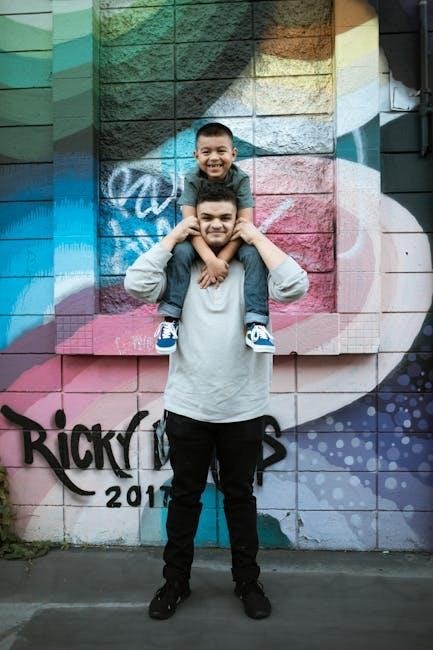
Expressive Art Therapy Activities for Children
Engaging activities include icebreakers, emotional expression through art, and group projects. These help children communicate feelings, build confidence, and develop social skills in a creative environment.
4.1 Icebreaker Activities
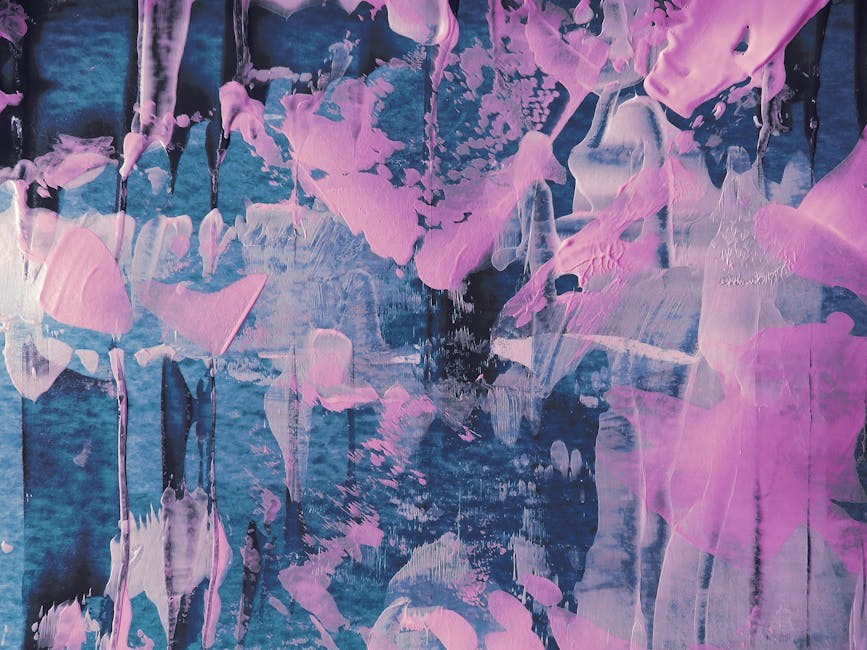
Icebreaker activities are designed to help children feel comfortable and engaged in therapy. These exercises often involve simple creative tasks like collaborative drawings or emotion-themed collages. They encourage interaction and trust among participants. For instance, “Feelings Charades” where kids act out emotions without speaking, or “Group Mural Painting,” fosters teamwork and self-expression. These activities set the stage for deeper emotional exploration, making therapy sessions more effective and enjoyable for young participants. They are essential for building rapport and initiating the therapeutic process.
4.2 Emotional Expression Through Art
Emotional expression through art allows children to communicate feelings that may be difficult to verbalize. Activities like creating emotion-themed collages or abstract paintings encourage self-reflection and catharsis. Drawing “Feelings Faces” or crafting symbolic sculptures helps children identify and process emotions. These exercises provide a safe, non-verbal outlet for expressing complex feelings, fostering emotional awareness and healing. Art becomes a language that bridges the gap between inner experiences and external expression, empowering children to navigate their emotions effectively. This approach is particularly beneficial for young individuals struggling to articulate their feelings verbally.
4.3 Group Collaborative Projects
Group collaborative projects in expressive art therapy foster teamwork, creativity, and shared expression. Activities like co-creating murals, collaborative sculptures, or shared canvases encourage children to work together, building trust and understanding. These projects often involve themes of unity, diversity, or community, helping participants develop social skills and empathy. The collective process allows children to see their contributions as part of a larger whole, promoting a sense of accomplishment and interconnectedness. Such exercises are particularly effective in group settings, enhancing both individual and group dynamics through creative collaboration.
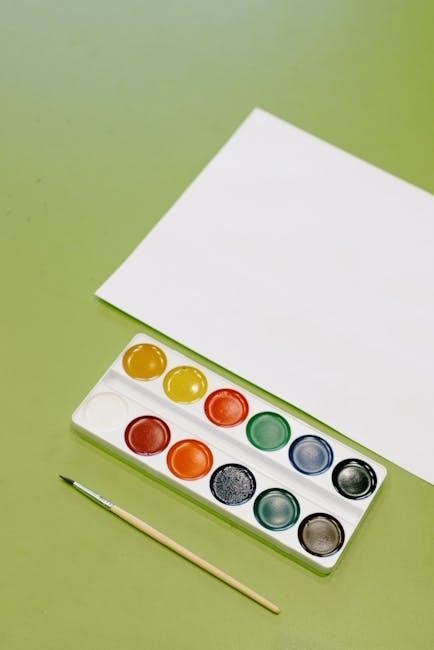
Expressive Art Therapy Activities for Adults
Expressive art therapy for adults includes activities like painting, music, and creative writing to explore emotions, reduce stress, and promote self-reflection and personal growth through artistic expression.
5.1 Stress Relief and Relaxation Techniques
Expressive art therapy offers various stress-relief techniques for adults, such as painting, drawing, and music. These activities help calm the mind and reduce anxiety. Guided sessions encourage mindfulness and creative expression, fostering relaxation. Participants can explore emotions through art, promoting emotional release and balance. Techniques like art journaling and movement exercises further enhance well-being. These methods provide a healthy outlet for stress, enabling individuals to reconnect with their inner selves and find peace in a chaotic world.
5.2 Exploring Identity and Self-Reflection
Expressive art therapy activities for adults often focus on self-discovery and identity exploration. Through creative mediums like painting, poetry, or collage-making, individuals can reflect on personal experiences and emotions. These activities encourage introspection, helping adults gain insight into their values, beliefs, and life journeys. By expressing their inner world artistically, participants can process complex feelings and develop a deeper understanding of themselves. This therapeutic process fosters personal growth and empowers individuals to embrace their unique identity.
5.3 Trauma-Informed Art Interventions
Trauma-informed art interventions use creative activities to help individuals process and heal from traumatic experiences. These interventions prioritize safety, choice, and empowerment, allowing participants to express emotions non-verbally. Techniques like painting, drawing, or collage-making provide an outlet for exploring trauma without direct conversation. The focus is on fostering resilience and rebuilding a sense of control. These activities are designed to honor the individual’s unique experience, promoting healing and integration of traumatic memories into their narrative. Creativity becomes a powerful tool for transformation and recovery.
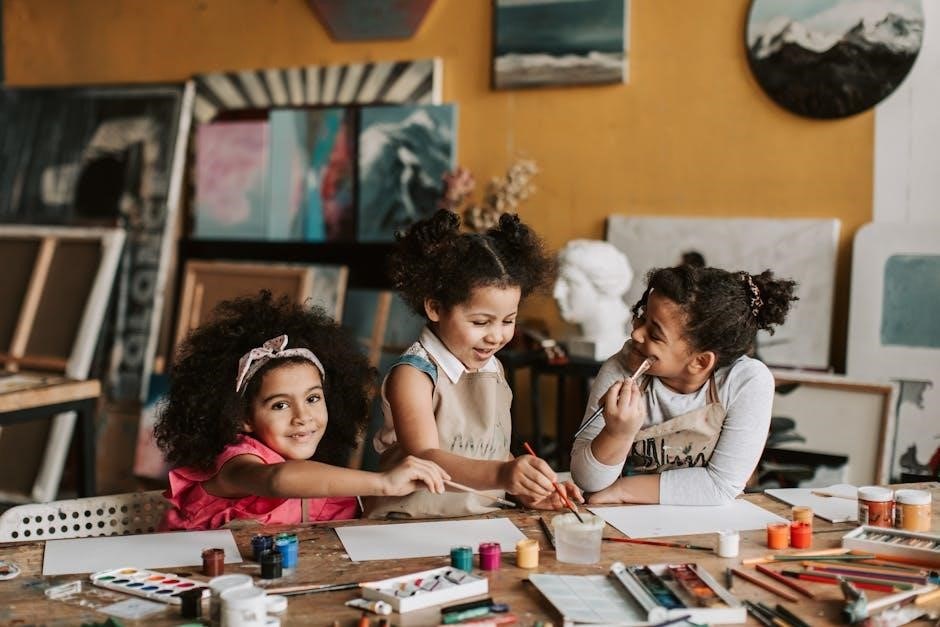
Implementing Expressive Art Therapy
Creating a safe, non-judgmental space is crucial for effective expressive art therapy. Selecting appropriate materials and guiding sessions with empathy fosters creative expression and healing.
6.1 Setting Up a Therapeutic Environment
Creating a safe, non-judgmental space is essential for expressive art therapy. Ensure good lighting, comfortable seating, and accessibility to art materials. A calming atmosphere fosters creativity and emotional expression. Displaying inspirational art or nature elements can enhance the environment. Organize materials to encourage exploration while maintaining order. Privacy and freedom from distractions are crucial for clients to feel secure. Adapt the space to accommodate diverse needs, ensuring accessibility for all participants. This setup promotes trust, relaxation, and openness, laying the foundation for therapeutic progress and healing through creative expression.
6.2 Choosing the Right Art Materials
Selecting appropriate art materials is crucial for fostering creativity and emotional expression in expressive art therapy. Use versatile supplies like paints, markers, clay, and collage materials to inspire diverse creative processes. Natural materials, such as fabrics or found objects, can evoke tactile experiences and deeper connections. Ensure materials are accessible and non-intimidating, encouraging participants to explore freely. Consider clients’ preferences and abilities when choosing tools, promoting comfort and engagement. The right materials can enhance therapeutic outcomes by fostering self-expression and emotional exploration.
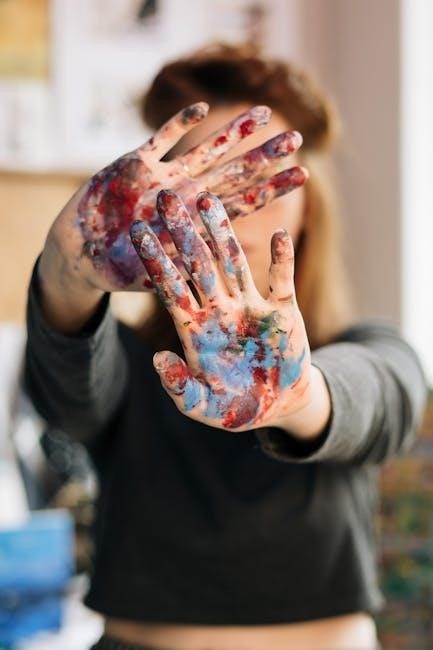
6.3 Facilitating Group Sessions
Facilitating group sessions in expressive art therapy requires creating a safe, supportive environment where participants feel comfortable sharing and exploring emotions; Encourage collaboration through activities like group murals or joint creative projects, fostering connection and mutual understanding. Provide clear guidelines while allowing flexibility for personal expression. Act as a guide, offering prompts or themes to spark creativity, and be prepared to adapt based on group dynamics. Ensure active listening and empathetic feedback to enhance the therapeutic experience and promote collective growth.
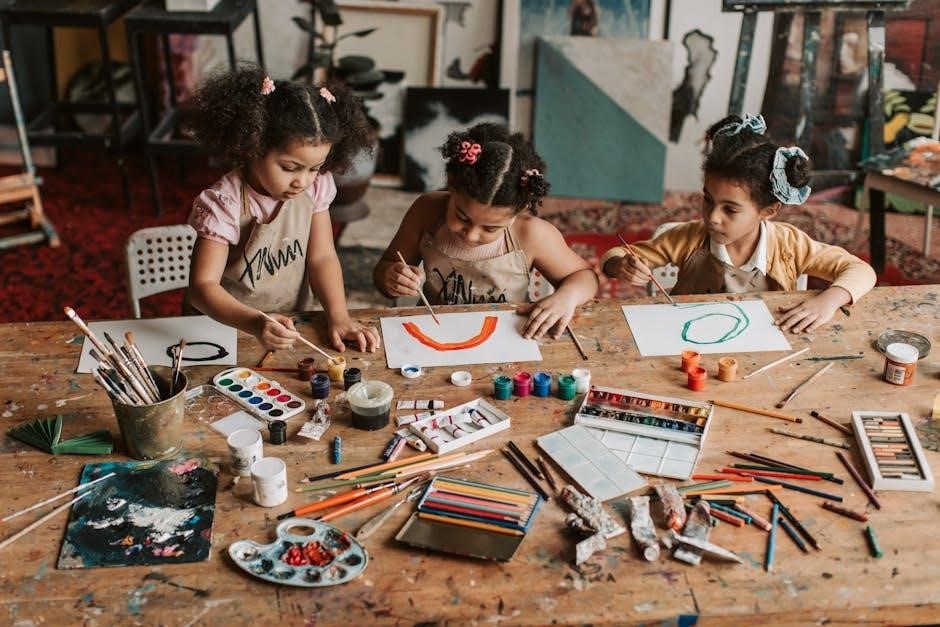
Case Studies and Success Stories
Case studies highlight individuals who achieved emotional healing through expressive art therapy, showcasing transformative journeys of self-discovery and growth.
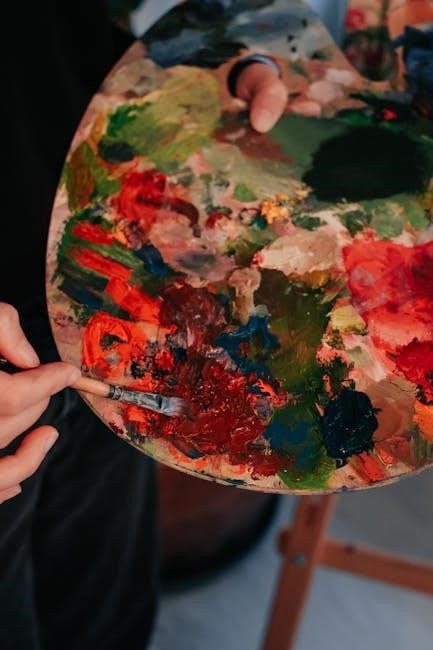
7.1 Individual Client Experiences
Individual clients often report profound emotional breakthroughs through expressive art therapy. Activities like painting and collage-making allow clients to process complex emotions and gain self-awareness. For example, one client used abstract art to express grief, leading to cathartic healing. Another found solace in creative writing, transforming trauma into empowering narratives. These personal journeys highlight the therapy’s ability to foster resilience, self-expression, and inner peace, demonstrating its transformative power in addressing unique individual needs and promoting lasting emotional growth.
7.2 Group Therapy Outcomes
Group expressive art therapy fosters connection and collective healing. Activities like collaborative painting or shared creative projects encourage trust and empathy among participants. Group settings often amplify emotional expression, as individuals inspire and support one another. Many clients report feeling less isolated, gaining new perspectives, and developing stronger interpersonal skills. The shared creative process strengthens bonds, promoting a sense of community and mutual understanding. These outcomes highlight the therapy’s effectiveness in enhancing social connections and emotional resilience within a supportive group environment.
7.3 Long-Term Benefits and Growth
Engaging in expressive art therapy activities fosters lasting emotional resilience and personal growth. Over time, participants develop greater self-awareness, improved problem-solving skills, and enhanced creativity. The therapeutic process encourages individuals to explore deeper layers of their emotions, leading to profound healing and self-acceptance. Long-term engagement also strengthens coping mechanisms, helping individuals navigate life challenges with greater confidence and emotional balance. The continuous creative expression supports sustained mental well-being, empowering individuals to embrace their unique journey of growth and transformation.
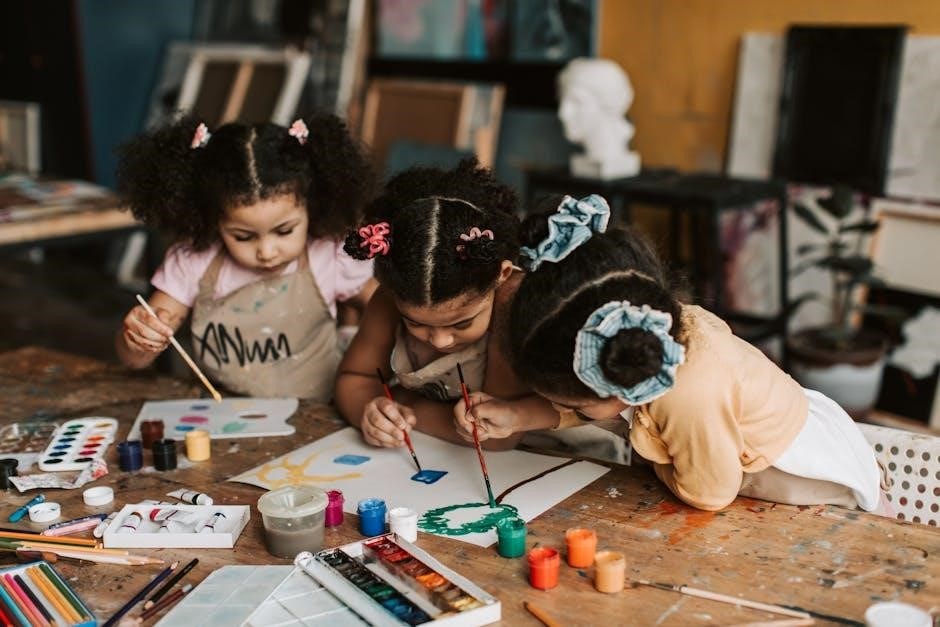
Cultural and Individual Adaptations
Expressive Art Therapy is adaptable to diverse cultural contexts and individual needs, ensuring accessibility and meaningful engagement for all participants, regardless of background or personal circumstances.
8.1 Tailoring Activities to Cultural Contexts
Expressive Art Therapy activities are often adapted to align with cultural values and traditions, ensuring relevance and resonance for diverse populations. Therapists incorporate local art forms, symbols, and practices to create culturally sensitive interventions. This tailored approach fosters a sense of connection and understanding, making the therapeutic process more effective and meaningful. By respecting cultural nuances, practitioners can address unique needs while promoting emotional expression and healing in a way that feels authentic to each individual or group.
8.2 Addressing Diverse Client Needs
Expressive Art Therapy activities are designed to meet the unique needs of diverse clients, including children, adults, and individuals with specific challenges. Therapists adapt techniques to accommodate different learning styles, abilities, and cultural backgrounds. For example, activities like painting or music may be tailored to help children express emotions, while adults might benefit from writing or drama to explore complex issues. This flexible approach ensures that each client feels empowered and supported in their personal journey of healing and self-expression.
8.3 Incorporating Personal Symbolism and Meaning
Expressive Art Therapy encourages clients to infuse their creations with personal symbolism, allowing for deeper emotional expression and self-reflection. Activities like collages or abstract paintings enable individuals to represent their feelings and experiences through symbols that hold unique meaning to them. This approach helps bridge the gap between conscious thoughts and subconscious emotions, fostering a therapeutic dialogue. By interpreting these symbols, clients gain insights into their inner worlds, promoting healing and personal growth in a meaningful and individualized way.
Expressive Art Therapy has proven effective in promoting mental well-being. Its growing popularity and research advancements highlight its potential. Continued exploration and participation are encouraged.
9.1 The Growing Popularity of Expressive Art Therapy
Expressive Art Therapy is gaining widespread recognition for its holistic approach to mental health. Its integration of art, music, and movement offers a unique path to emotional healing. The surge in popularity stems from its accessibility and effectiveness in addressing diverse mental health challenges. As awareness of mental well-being grows, so does the demand for creative therapeutic methods. This approach complements traditional therapies, making it a preferred choice for many. Its adaptability to various populations ensures its continued growth and acceptance in modern therapeutic practices.
9.2 Advancements in Research and Practice
Recent studies highlight the effectiveness of expressive art therapy in addressing mental health challenges, fostering emotional healing, and enhancing well-being. Advances in research have led to a deeper understanding of how creative expression impacts psychological processes. Practitioners are now incorporating trauma-informed approaches and cultural adaptations to make therapy more inclusive. The development of evidence-based practices ensures that expressive art therapy is both effective and accessible. These advancements are driving its integration into mainstream mental health care, making it a vital tool for modern therapeutic interventions.
9.3 Encouraging Continued Exploration and Participation
Encouraging ongoing exploration of expressive art therapy fosters creativity and emotional growth. Community workshops, online resources, and collaborative projects inspire individuals to engage deeply with therapeutic activities. By sharing success stories and providing accessible materials, such as activity guides, participants are motivated to continue their journey. This sustained engagement promotes long-term healing and self-discovery, ensuring the benefits of expressive art therapy are experienced by an ever-growing audience.